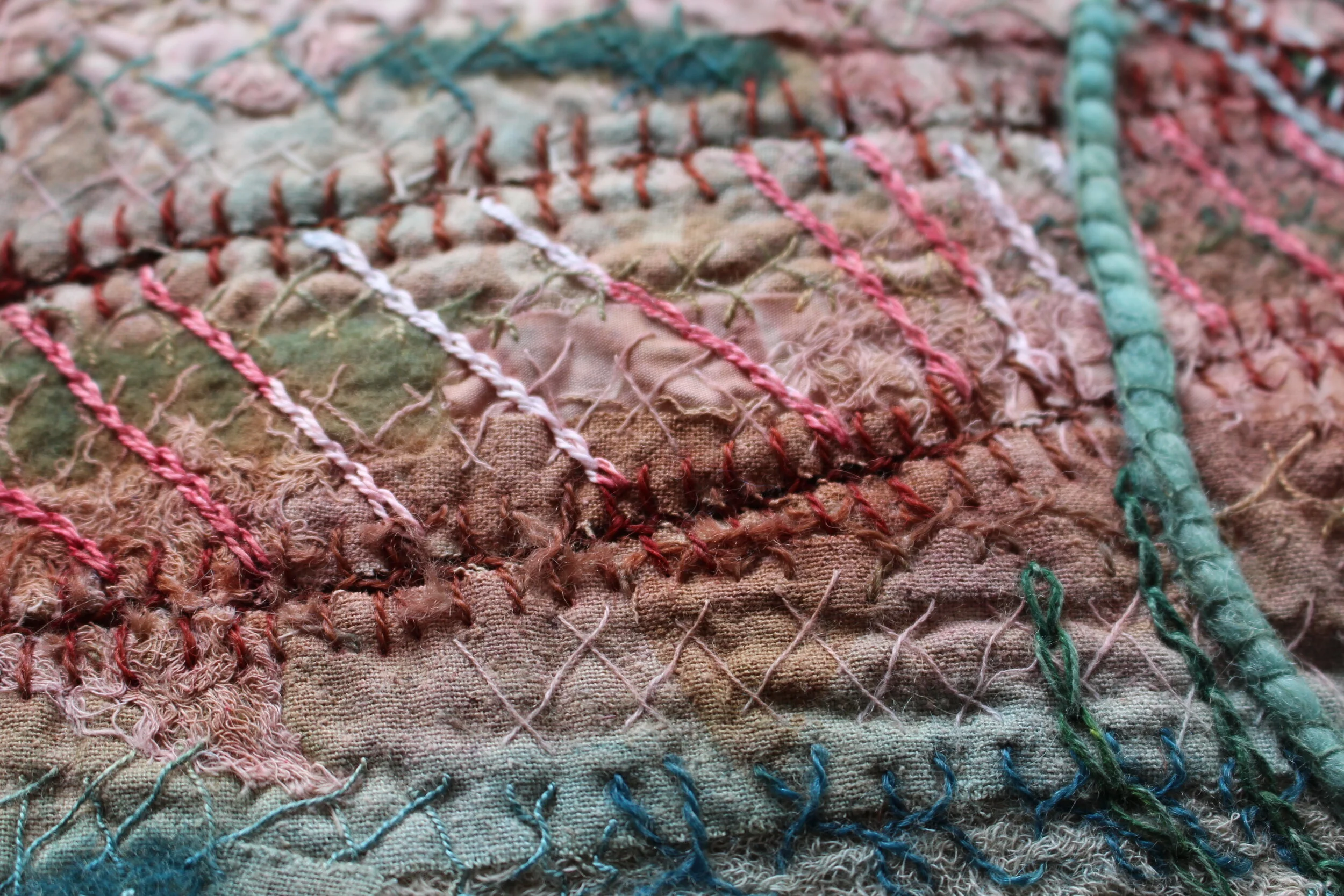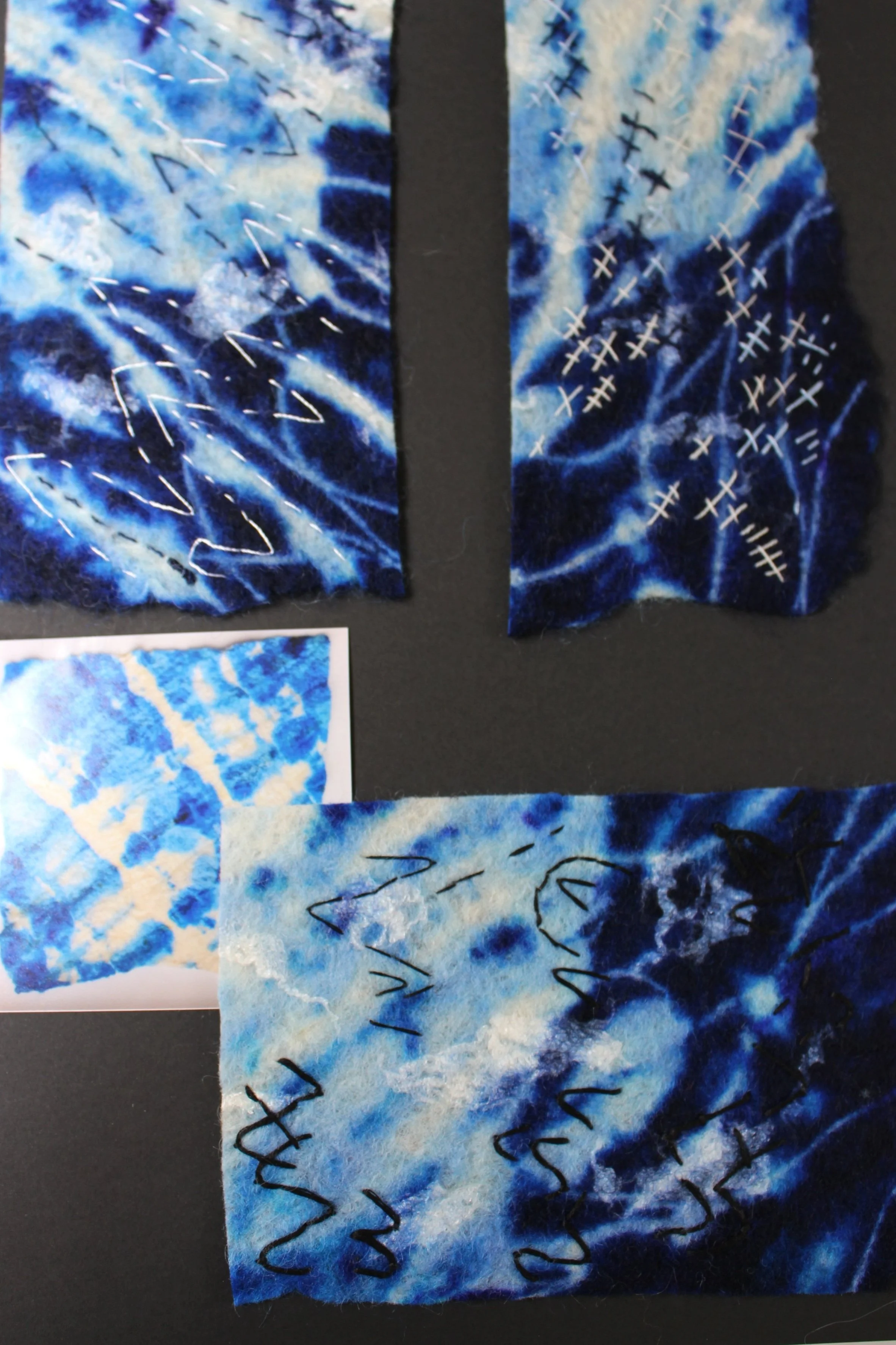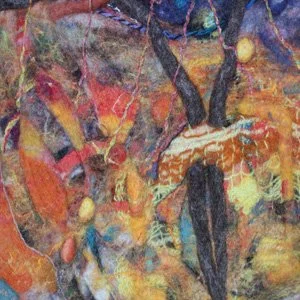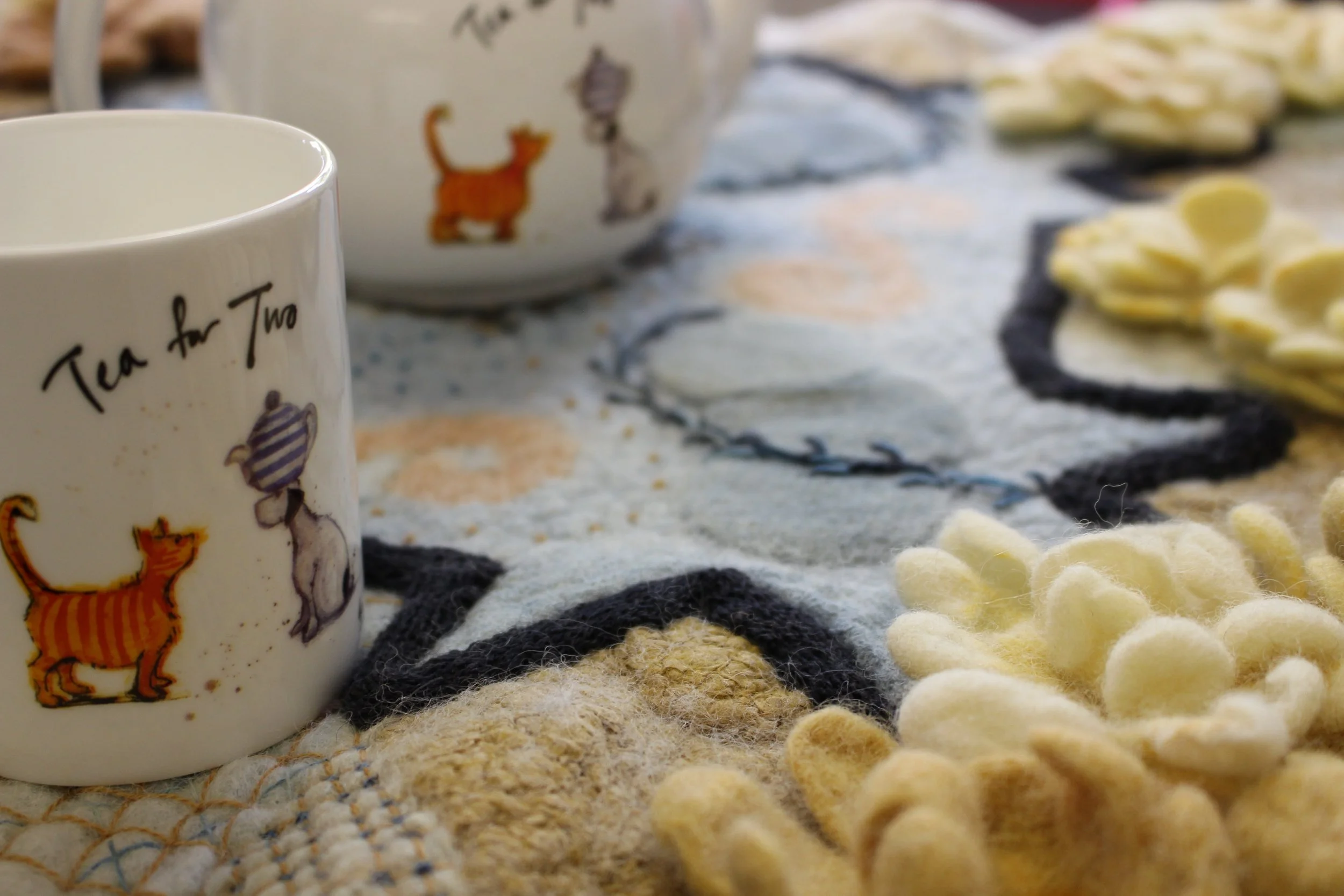I want to be that person who has ‘tremendous spirit’ and who is willing to put creative effort into their life. I am an artist because I want to be one.
Eco Art from the heart
Don't race to the end - enjoy every element!
Why are Textiles not Art?
From Stitch to Embroidery
Creative Computing: Finding the Narrative in a Photo
Looking at the work of others
Mark-Making in Felt
A single mark, whether produced by pencil, pen, brush or needle can be meaningful and effective, but the combination of marks, layered in complexity was a challenge.
I realised that I needed to consider not only the marks I want to produce, but how the choice of fibres, the order of working, the effects of scale and shrinkage, the migration of colour through the layers all play their part and affect the finished result.
Maths and Art – DON’T PANIC! It can be pretty!
I am not a mathematical person and it helps if your tutor loves maths!
I am fascinated by the way in which maths explains nature but doesn’t define it. I did research certain mathematical concepts which are rhymical and repetitious in nature – the Fibonacci Principle and the Golden Ratio and I looked at geometry in nature. I like the concept of drawing a spiral that replicates those found in nature from drawing squares according to the Fibonacci Principle. In the context of my work the spiral represents the proboscis of the moth.
“From the simplest observation in nature to detailed measuring of intricate forms we find geometry everywhere in the world around us.” Geometry in Nature by John Blackwood. John shows how many forms in nature are generated by the same basic geometic process. I enjoy looking at how nature is explained by geometry even though numbers are not my thing. I see the visual connections of shape, repetitions and forms which I enjoy and can take forward in my designs.
Bridget Riley’s work suggests movement by colour juxtaposition within the variation of the lines and shapes she has meticulously calculated. Her geometric paintings implore the viewer to reflect on how it physically feels to look, her objective being to interrogate what and how we see and to provoke uncertainty and clarity with her paintings, allowing the viewer to complete the experience of the painting. By looking at the work of Bridget Riley I have a deeper understanding of my own voice and how I can say it within my work.
There are a couple of quotes by Bridget Riley that resonate with me:
"For me nature is not landscape, but the dynamism of visual forces."
“If you allow colour to breathe, to occupy its own space, to play its own game in its unstable way, it’s wanton behaviour, so to speak. It is promiscuous like nothing.”
By Maggy Lightfoot
Seeing the unseen – the beauty of moths!
Felting with a machine. Who I am!
I inherited a small amount of money from my grandparents and bought a Groovi 1000 felting machine. This has pressure rollers and was the main felting machine around at the time. I attended a workshop at Artybird Carnforth with Rod Welch and Karolina Arvilommi and as Rod had developed a similar felting machine some years earlier their influence was helpful.
I experimented with wrapping methods and using different pressures during felting and resulted in enabling me to make the felt I want. It will cope with some low relief and I often layer the felts at different stages, building it up as I go. One of the experiments was to use the pressure to compact dry fibres so I didn’t have to carry heavy wet felt to and from the machine. This was very successful and created a thick ‘half-felt’ that I was able to cut into shapes or use as a layer.
Many other tools are available to help with different stages of felting and one of my favourites is the original felt rolling pin, which I use at all stages of making. Kate and I researched many other felting tools and published our findings in Felt Matters, the IFA magazine.
The embellishing machine is a godsend for adding lines and details as well as texture. I also blend most of my fibres to create the colours I want and for this I use a drum carder and a blending board.
One of H. Jackson Brown’s inspirational quotes is: “However difficult life may seem, there is always something you can do and succeed at.”
By embracing the need for help with tools I can be who I am.
By Maggy Lightfoot
Felting with a disability. Slow Felting!
Arts and Health
Functionality-it doesn’t have to be on the wall to be art.
Is it OK to remove pages from a book?
The Oxford Dictionary defines a book as an object containing a bound set of written or printed work consisting of pages glued or sewn together along one side and bound in covers. Some people buy a collection of books to place on their bookshelf, like pieces of art, or as a backdrop to promote their professional or political orientation, as seen during lockdown online conversations. I personally view a book as being more than its cover, a book is only fully functional when knowledge has been extracted from its pages and used.
Recently, I was telling a friend about my floating bookcase project and the way in which I was re-purposing books. What do you mean they asked? ‘Well,’ I answered ‘I have taken old worn-out book covers, stripped out their pages then used the spine of the book cover to print onto canvas’. They were horrified that anyone would sacrifice a precious book, suggesting instead that I should have placed them on a shelf, just in case someone, sometime in the future needed to use them. But then again through my textile design I am intentionally using imagined language to share stories with human connections and ideas that have a modern relevance. And using a familiar narrative of books on a bookshelf, expecting the viewer to see and interpret the world around them with meaning or significance.
Whether you see my action as sacrilege or re-purposing old books, the aim is to target the willingness of the audience to mentally participate in the construction of narratives. For some this piece may remind them of lived experiences and their personal relationship with books, this could be family memories, from education, from social history such as the deliberate destroying of books or the migration from physical to digital books.
By Diane Daune - Fellowship Student
How NEAT does YOUR pattern have to be?
Pablo Picasso is credited as saying ‘Learn the rules like a pro, so you can break them as an artist’; whilst Oscar Wilde’s statement ‘art is the most intense mode of individualism that the world has known’ suggests a level of competence that enables the artist to display mastery in unique, uncertain and conflicting ways.
So, WHAT is neat? Is this the time we take to construct straight edges and symmetrical patterns?
I wanted my explorations to be free of ‘ought’s'. What we OUGHT to do, think and say about the work we make. For me a simple plane has no depth other than that created by the optical illusion of a busy tessellation.
I like to take sections of a design or photo, and then FOCUS in on a particular area before expanding the familiar, by cutting, repositioning and expanding lines to create texture in a freeform interpretation of the tessellations.
My work illustrates a strong understanding of visual language, as I use motifs, shapes, pattern and decorative lines to establish repeats, flow, and rhythms within complex compositions. These EVOLVE with my work, as I trust my instincts, and reflect on the process.
I want the eye to MOVE across a resolved well-presented piece in a relaxed way, with the design creating gentle movement suitable for a calming lived environment rather than the busy tessellation patterns fashionable in the 1960, and the Victorian era.
By Diane Daune - Fellowship Student
Sampling for Design
We all know how much of a commitment it can be to create a textile piece, whether it is a practical garment or an artistic hanging. Wouldn’t it be fantastic if there was a way we can experiment, practice and create WITHOUT such a large commitment? Wouldn’t it be also helpful if there was a method to break down the steps needed to produce the beautiful things we want to create?
Fortunately, there is! A way to research, practice and play. Sampling!
Sampling for design allows us to work in the craft area of our choice regardless of our knowledge of that craft area. The method is always the same, creating a piece of cloth or fabric that represents a larger whole.
Through sampling we show the type of fabrics which we want to use, demonstrate how colours and different materials and trimmings will look before making a greater commitment. Sampling also gives us a way to see how colours and patterns appear on actual fabric, rather than on a paper or digital design. It might go without saying but fabric is a great deal different to paper or digital!
It is ALWAYS an enlightening process to extend your knowledge of different tools and materials, sampling allows us to dip our toe in the water and give a sense of progress as we compare our different samples using a new tool, technique or material.
This research can also extend into deliberately working in the style of other makers, we all know looking and reading is a lot different than actually doing! With both tools and materials, style and technique we can learn AND document the constraints that govern our craft area how these can work with design concepts.
Sampling for research allows us to move from knowing these issues to experiencing these issues in the work undertaken. This experience allows us to understand the visual language we’re working with, and, through repetition and exploration, the visual language becomes intuitive in our use in our craft.
Nothing stands still! Developing knowledge of our tools and materials is critical to our creative development. Sampling for practice allows us to build that experience and hone our skills over time. But beyond practicing skills, sampling allows us to make connections across different craft areas and lets us build overlapping awareness across those different areas. With this practice we can begin to go beyond understanding the visual language of textiles and develop our own visual language.
Sampling allows us to explore design concepts in our craft areas as well as develop our very own way of working with textiles. This lets us find our own unique voice within our craft’s visual language.
All this sampling builds to the point where we are not only able to break down the creative steps in creating our projects but also ensure that we can create unique cloth that has our own unique voice!
Sketchbooks and YOU!
Sketchbooks are a VITAL design tool for any creative. Although the word sketch is most often connected with drawing, it can actually refer to a rough or unfinished version of any creative work OR a brief account or general outline of something.
With this in mind, sketchbooks can be thought of as ‘collect books’ where we can record observations, experimentations and ideas. In any medium we like, including textiles. Then we can visually connect different sketches or show our creative narrative to others.
Sketchbooks can be broken down into roughly two different purposes; to carry with us and to collate and exhibit our work. The first use is the typical idea of a sketchbook. A book that we can carry with us that allows us to stop and record ideas, the world around us, to record experiences that include ALL our senses! This record could be in either quick sketch ‘snapshots’ or longer studies. In this use, the sketch book is a visual diary.
This personal record allows us to be taken back to that place, to that moment that notes our place in the world.
The only thing to consider for this use is portability. The format can be a book, concertina, octopus or fabric. As textile makers, we should also take portable craft materials with us so we can respond directly to the place, time or our ideas.
The digital world expands the possibilities of our sketchbook. David Hockney has used a digital sketchbook since 2009, drawing with his thumb on his iPhone before moving on to a stylus and iPad.
Digital technology also affects the second sketchbook purpose, to collate and exhibit our work. Sketchbooks for this purpose are less about portability but more about the correct way to bring work together and create a story for others flicking through. Traditional sketchbooks can be large scale folios, small and medium scale sketch books or fabric books. Digital sketchbooks allow us to use cloud storage, image manipulation and contextual links so our sketchbooks can hold and use our work in ways that we could never confine to a single book and create new opportunities for inspiration.
This is the real purpose of the collation and exhibition of our work. Inspiration! For us, as we flick through our work, we can sort out disparate ideas and directions. This activity allows us to sort out our head so we can actually SEE our work! This helps us to resolve ideas and aids us as a tool in our creative progression.
We may only think of sketchbooks as scrap books, fragments of creativity that we can only seek to improve.
But our sketchbooks can be fascinating creative works in and of themselves, allowing others to follow our ideas, our story, our progression. A compelling companion that explains our work in an exhibition or a standalone collection of inspiration for others!
More thoughts on Creativity
“I am inspired”.
Do creative thoughts differ from regular thoughts? Can it help us to be creative or more creative to understand any possible differences? Quite possibly! The creative process is one which is fraught with danger. Some don’t want to think about it in case the fragile magic gets broken. Others want to nail down exactly what it is. Most of us exist somewhere in between. We know if we want to be consistently creative, we need some kind of habit or routine (dare we call it a ritual?) but recognise the process can be elusive, the same thing doesn’t always work… a creative block would be SO much easier if we could simply unblock it!
To start let’s look at thinking. There are three broad types of thinking. These can be characterised by 3 types of objects. This could get tricky without some ‘visuals’!
A ladder. A tree. A spiderweb.
The ladder is the analogy for logical and rational thinking. One thought or step leads to another, taking you from where you ‘are’ to where you would like to ‘be’. We don’t necessarily need to know where we are going (although it certainly helps) as each step builds on the previous one and includes it, reducing everything down to the simplest version of the thought(s) before moving on. This builds a strong thought tower BUT it also means we are rejecting all other possibilities at each step. If we hit an obstacle… the tower falls.
The tree is the analogy for lateral thinking. Starting at the roots, we draw in all the information we need until we have the trunk, the solid understanding of what we are doing or want to achieve. This can be seen as the problem-solving approach, the more we know about the problem, the easier it becomes to solve. Once we have gathered all the roots of information we can then start moving up through branching possibilities. Although this mode of thought has advantages over logic, it is still ‘hierarchical’, in that the thoughts build, and the branches mean that thoughts become binary nodes (something is either ‘this’ or ‘that’) and while exploring more possibilities than the logical approach there is very little to connect all the branching possibilities.
Finally, there is the spiderweb as an analogy for rhizomatic thinking (a rhizome is a botanical term for subterranean stems such bulbs or tubers) as identified by Deleuze and Guitari in 1980. Each node can connect with each other, there is no hierarchy, so you can enter the web at any place within it and easily orient yourself and progress. No thought is more important than another, no idea resonates more strongly. The web allows easy travel through out it, building itself where It needs to and allowing multiple cycles of travel around the nodes you want. The downside here is that there is no start or end, structuring and prioritisation becomes an issue.
Creative thinking requires all three modes of thought. As creatives, rhizomatic thought might feel the most comfortable for us and where we can almost effortlessly draw ideas by making new connections. Lateral thought allows us to filter the web, creating some priorities and structure while logical thought allows us to rigorously develop a process while also communicating our intent through language.
Yet other disciplines can also benefit from the different modes of thought. Scientists, mathematicians and engineers all require these modes of thought to truly become masters of their field.
And perhaps we as creatives, just need to shift our mode of thought when we come against an artistic block!
Connections in Textiles
How much of our textiles are ‘just’ objects? Useful. Practical. Maybe even nice to look at. How many of our textiles are connected to moments in time? To people? To powerful emotions that we don’t want to let go of. An argument can be made that most of the textiles we own falls onto the side of connections. Even, perhaps, that textiles are ALL about connections, not just in the weave or stitch but in the fabric of our memories and emotions. And that if we forget that then our lives, our culture and perhaps our planet will suffer.
One of our earliest memories is often of the fabrics that surround us. Their colours, their warmth, their feel, and their smell. Your baby shawl created by a close family member or friend that has perhaps travelled down through the generations. Maybe your mother’s nightie or your father’s shirt. Or the curtains in your first room. All these are objects that serve a purpose and for everyone else maybe are just that. Yet to YOU they are something more.
They are a reminder of the first feelings of love. A symbol of an unbroken legacy. An introduction to a favourite colour or even, for many of us, a gateway into why we create with fibres and fabrics!
As we grow older these tactile connections of colour and comfort become the gifts that we give to those we care about. Curtains and cloths, tops and towels, bags and bookmarks. A birthday. A Christmas. An anniversary. A going away present. A welcome home gift. A textile object that bridges a gap between two people and creates a connection.
When our loved ones are gone, we can still feel that connection, remember those moments when those gifts sometimes find their way back to us.
If our connection to these emotional artefacts is strong enough, we pick up the needle, the loom or the spinning wheel and connect with our cultural past stretching back 20,000 years! We learn the skills that have kept ourselves warm. That have helped identify us. That have let us express ourselves. There is real joy in the making, joy in the using and joy in the giving.
Machine made fabrics are convenient and cheap but perhaps the hyper-industrialisation of fashion and fabric threatens these connections by cheapening their meaning to us. If it is easier to buy a new top than to fix one, does that make it better?
There is an ever-growing movement of not just recycling but of upcycling, of reinvention and repurpose that allows us to keep items, keep using them and create stories and new connections with them. Someone after all has been behind that object. Designed it. Selected the colour and the style. If picking up from a shop with pre-loved items… that object has been a moment in time for someone else BEFORE US.
If we can teach and learn about fabrics, fast and slow fashion, it will allow us to honour the connections and the skills that have gone into those items. We can preserve our craft and pass it on.
Finally, we can save our planet from the unneeded waste of the unconnected ‘new’.












